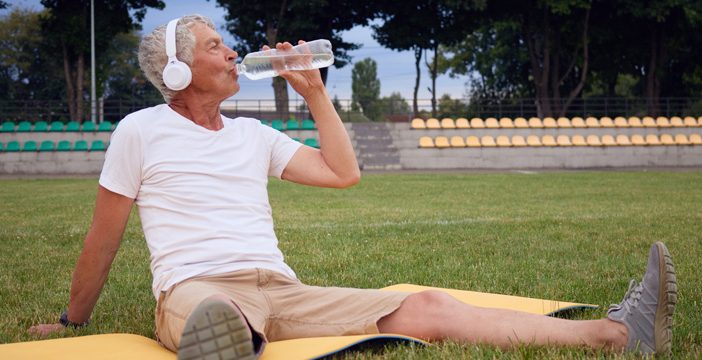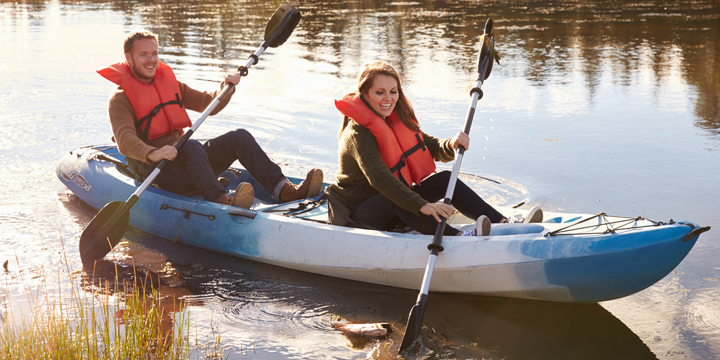
We wait so long for the summer heat to arrive that it’s easy to get carried away by the hot sizzling days and overdo outside activity. The same is often true when we go on winter vacations down south.
Older adults and people with chronic diseases, such as diabetes and hypertension, have a reduced ability to dissipate heat at rest and during physical activity. Protective mechanisms, which typically help the body cope with increased temperatures, are not as effective. This includes responses in the brain, blood vessels, sweat glands and cells. Importantly, greater demand is placed on the heart and blood vessels due to redistribution of blood flow to the skin to aid in body cooling. This increase in workload, coupled with a reduced capacity to anticipate and respond to elevations in stress during hot conditions, likely contributes to a greater risk of adverse events.
Follow these 10 tips for exercising in the heat, to help you stay safe and maximize your workout efficiency during the hot weather.
1: Take time to adjust to the heat
Give your body time to adjust to activity in higher temperatures. Start with short periods of outside activity for a few days, and then gradually increase the intensity and duration of your workouts over a week or two. This will help your body adapt to the stress of hot conditions, improving your ability to sweat and cool down efficiently.
2: Exercise at cooler times
Avoid physical activity in the hottest part of the day, which is usually shortly before and after midday. Instead, plan for outdoor exercise earlier in the morning or in the late afternoon or evening hours.
3: Drink lots of water
Avoid dehydration by carrying a bottle of water with you whenever you exercise. Avoid coffee and alcohol, which can be dehydrating. Drink plenty of water before, during and after your workout to stay hydrated. Avoid drinking sports drinks – although they contain water and electrolytes, they also contain carbohydrates which can impact blood sugar levels. Sports drinks are not needed by most people unless they are very active individuals or athletes. It is important to check your blood sugar levels often (before, during, and after exerise) when you are in extreme heat conditions.
4: Look for opportunities to cool the body
You may want to start your activity with a cool shower. Activities like swimming will help to keep the body cool and comfortable. If this isn’t possible, a quick splash in the water from a park fountain or children’s playground can help to cool you down. If you start to feel over-heated, dip a towel or piece of clothing in cold water and place it on the back of the neck.
5: Exercise in air-conditioned comfort
Keep up your physical activity during very hot days in the cool comfort of a gym. Alternatively, take a brisk walk around an air-conditioned shopping mall.
6: Avoid going barefoot
Barefoot activities are best avoided at all times by people with diabetes, due to the risk of injury to the feet. Going barefoot on hot surfaces will add to these risks.
7: Dress for the heat
Wear loose, lightweight, moisture-wicking, light-coloured clothing made out of breathable fabrics. Always wear a hat and sunglassess in the sun.
8: Don’t skimp on sunblock
Protecting your skin from harmful UV rays is essential when exercising outdoors. Always use sunblock with an SPF of at least 30 when you are outdoors. Remember to apply it to your ears, neck and the back of your hands as well. Reapply it after intense sweating or if you get wet.
9: Ease up on exercise intensity
Reduce the intensity of your workout to prevent overheating. During very hot temperatures, plan on light intensity activity such as walking or light jogging. This is especially important during the hotter times of day. Listen to your body and be willing to slow down or take breaks as needed.
10: Be alert for heat exhaustion
Symptoms can include light-headedness, headache, dizziness, muscle cramps and rapid heartbeat. Later symptoms can include nausea and vomiting. If symptoms occur, halt the activity, move to a cool place, and drink water or a sugar-free drink. Keep an eye on your heart rate to ensure you are not overexerting yourself. High temperatures can cause your heart rate to spike more quickly. Using a heart rate monitor can help you stay within a safe range and prevent overheating.
The environment is changing more rapidly than scientists anticipated. With it, we are experiencing an increased frequency of extreme weather events. Remember, heat-related illnesses are largely preventable. Take precautions and enjoy a safe summer outdoors!



